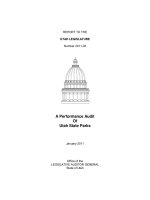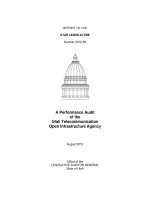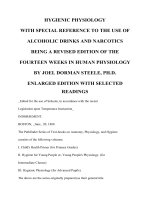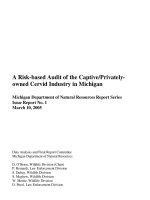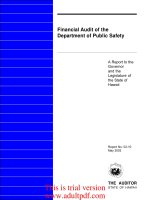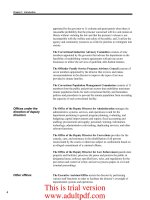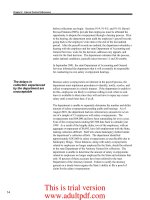A Performance Audit of the Utah Telecommunication Open Infrastructure Agency ppt
Bạn đang xem bản rút gọn của tài liệu. Xem và tải ngay bản đầy đủ của tài liệu tại đây (2.89 MB, 88 trang )
REPORT TO THE
UTAH LEGISLATURE
Number 2012-08
A Performance Audit
of the
Utah Telecommunication
Open Infrastructure Agency
August 2012
Office of the
LEGISLATIVE AUDITOR GENERAL
State of Utah
Office of the Legislative Auditor General
STATE OF UTAH
315 HOUSE BUILDING • PO BOX 145315 • SALT LAKE CITY, UT 84114-5315
(801) 538-1033 • FAX (801) 538-1063
JOHN M. SCHAFF, CIA
AUDITOR GENERAL
Audit Subcommittee of the Legislative Management Committee
President Michael G. Waddoups, Co–Chair • Speaker Rebecca D. Lockhart, Co–Chair
Senator Ross I. Romero • Representative David Litvack
August 1, 2012
TO: THE UTAH STATE LEGISLATURE
Transmitted herewith is our report, A Performance Audit of Utah
Telecommunication Open Infrastructure Agency (Report #2012-08). A digest is
found on the blue pages located at the front of the report. The objectives and scope
of the audit are explained in the Introduction.
We will be happy to meet with appropriate legislative committees, individual
legislators, and other state officials to discuss any item contained in the report in
order to facilitate the implementation of the recommendations.
Sincerely,
John M. Schaff, CIA
Auditor General
JMS/lm
Office of the Utah Legislative Auditor General
i
Digest
A Performance Audit of
Utah Telecommunication Open
Infrastructure Agency
The Utah Telecommunication Open Infrastructure Agency
(UTOPIA) is an interlocal agency aimed at providing its users with
some of the most advanced communications services available. The
agency is building a wholesale fiber-optic network that offers its users
access to high-speed video, data, and phone services. Once completed,
supporters of the network believe it will help improve the quality of
life for city residents and promote economic growth for the business
community. Due to a number of unforeseen challenges, the agency
was unable to complete construction of the network as quickly as
planned. This report describes some of the challenges UTOPIA faces,
the possible causes for those challenges, and suggestions for
strengthening organizational oversight and accountability.
UTOPIA’s Ambitious Goals Have Not Been Met. UTOPIA
originally planned to build a broadband network in three years and to
achieve a positive cash flow in five years. However, it has not met that
schedule. Instead, the cost of financing and operating the network
increased before UTOPIA could provide a substantial number of
customers with service. As a result, revenues have not been sufficient
to cover its costs. Year after year, as operating deficits have accrued,
the agency has developed a large negative asset balance.
UTOPIA’s Bond Proceeds Were Not Put to Productive Use.
UTOPIA has issued $185 million in bonds to pay the cost of building
its fiber-optic network. Most of the bond proceeds have been invested
in poorly utilized and partially completed sections of network. As a
result, the network is not generating sufficient revenue for the agency
to cover its annual debt service and operating costs.
UTOPIA Used Bond Proceeds to Cover Operating Costs and
Debt Service. Slow progress in building the network and a general
lack of subscribers have forced UTOPIA to use a large portion of its
bond proceeds to cover operating deficits and debt service costs. The
use of debt to cover the cost of operations and debt service is
symptomatic of an organization facing serious financial challenges.
Chapter II:
UTOPIA Faces a
Challenging
Financial
Situation
Chapter I:
Introduction
A Performance Audit of the Utah Telecommunication Open Infrastructure Agency (August 2012)
ii
Poor Planning, Mismanagement, and Unreliable Business
Partners Have Contributed to the Agency’s Financial Difficulties.
UTOPIA’s board members, staff, and outside consultants readily
admitted that mistakes were made during the rollout of the network.
To summarize, the mistakes they described generally began before
UTOPIA’s current management’s tenure and fall into one of the
following three categories: (1) poor construction planning, (2)
mismanagement, and (3) unreliable business and finance partners.
A Lack of Sufficient Subscribers Also Contributes to UTOPIA’s
Condition. In addition to UTOPIA’s problems with poor planning,
mismanagement, and unreliable business partner performance, a lack
of sufficient customers is also a cause for the agency’s slow progress.
UTOPIA’s historic and current subscriber rates, coupled with its
revenues, strongly suggest either a lack of consumer demand or an
agency inability to meet the consumer demand that does exist. A
contributing factor to UTOPIA’s difficulty in meeting targets may also
be its wholesale-only operating model.
Better Management and Financial Controls Are Needed to
Improve Accountability. UTOPIA can increase its chances of success
by taking steps to hold its staff and business partners accountable for
results. Even if UTOPIA has prepared a viable new development
strategy, it will not be successful unless the agency and its partners can
execute that plan. For this reason, we suggest that UTOPIA’s board
and management team adopt a number of management and financial
controls that will strengthen their oversight of the agency and their
ability to hold people accountable for the results they seek.
Chapter IV describes four steps UTOPIA should take to
strengthen its oversight and accountability:
Adopt better management controls, including written narrative
plans, formal policies, and performance measures.
Adopt the financial controls commonly used by public
agencies.
Improve compliance with the Utah Open and Public Meetings
Act.
Strengthen board oversight of agency operations.
Chapter III:
UTOPIA’s
Financial Woes
Attributed to
Many Different
Causes
Chapter IV:
Improved
Accountability
Will Increase
Likelihood of
Success
REPORT TO THE
UTAH LEGISLATURE
Report No. 2012-08
A Performance Audit of the
Utah Telecommunication Open
Infrastructure Agency
August 2012
Audit Performed By:
Audit Manager Rick Coleman
Audit Supervisor James Behunin
Audit Staff Matthew Harvey
Table of Contents
Digest i
Chapter I Introduction - 1 -
UTOPIA Is a City-Owned Telecommunications Network - 1 -
Audit Scope and Objectives - 3 -
Chapter II UTOPIA Faces a Challenging Financial Situation - 5 -
UTOPIA’s Ambitious Goals Have Not Been Met - 5 -
UTOPIA’s Bond Proceeds Were Not Put to Productive Use - 13 -
UTOPIA Used Bond Proceeds to Cover Operating Costs and Debt Service - 19 -
Chapter III UTOPIA’s Financial Woes Attributed To Many Different Causes - 23 -
Poor Planning, Mismanagement, and Unreliable Partners Led to UTOPIA’s Poor
Performance - 23 -
A Lack of Sufficient Subscribers Also Contributes to UTOPIA’s Condition - 32 -
Chapter IV Improved Accountability Will Increase Likelihood of Success - 39 -
UTOPIA Has a New Development Plan Aimed at Avoiding Past Mistakes - 40 -
UTOPIA Can Improve Accountability through Better Management Controls - 42 -
UTOPIA Can Strengthen Its Financial Controls - 47 -
UTOPIA’s Board of Directors Can Provide More Effective Oversight - 51 -
Recommendations - 56 -
Appendices - 57 -
Appendix A - 59 -
Appendix B - 65 -
Agency Response - 73 -
Office of the Utah Legislative Auditor General
- 1 -
UTOPIA is a municipal
fiber-optic network
owned by 11 Utah
cities.
Chapter I
Introduction
In 2002, a group of cities formed the Utah Telecommunication
Open Infrastructure Agency (UTOPIA). Their goal was to build an
advanced communications network that would offer broadband
services to each home and business within their cities. However, due
to a number of unforeseen challenges, the agency was unable to
complete construction of the network as quickly as planned.
Furthermore, poor construction planning, mismanagement, and
unreliable business partners have placed the agency in a precarious
financial situation. This report describes some of the challenges
UTOPIA faces, the possible causes for those challenges, and
suggestions for strengthening organizational oversight and
accountability.
UTOPIA Is a City-Owned
Telecommunications Network
UTOPIA is an interlocal agency aimed at providing its users with
some of the most advanced communications services available. The
agency is building a wholesale fiber-optic network that offers its users
access to high-speed video, data, and phone services. Once completed,
supporters of the network believe it will help improve the quality of
life for city residents and promote economic growth for the business
community.
UTOPIA Is Comprised of
Eleven Pledging Member Cities
UTOPIA was formed as an interlocal agency under the Utah
Interlocal Cooperation Act (Utah Code 11-13-101 et seq.). Eleven
member cities agreed to pledge some of their sales tax revenue as a
security guarantee for UTOPIA bonds. Several years later, after
UTOPIA encountered financial difficulties, nine cities formed another,
related entity called the Utah Infrastructure Agency (UIA). Through
the UIA, eight of those cities were able to raise additional funds
needed to continue construction of the network by pledging some of
their franchise tax revenue. The UIA has no staff of its own but
contracts with UTOPIA to build that portion of the network which
A Performance Audit of the Utah Telecommunication Open Infrastructure Agency (August 2012)
- 2 -
UTOPIA was created to
bring high speed
telecommunications to
member cities.
will be funded through UIA financing. Both UTOPIA and UIA are
overseen by separate boards of directors comprised of administrators
or elected officials from their member cities. Figure 1.1 lists the
UTOPIA member cities and those which have formed the UIA.
Figure 1.1 UTOPIA and UIA Network Membership. UTOPIA has 11
pledging Utah cities. Eight pledging cities went on to form the UIA, which
raised the additional funds needed to complete construction of the
network.
Member Cities
1
UTOPIA UIA
Brigham City
X
X
Centerville
X
X
Layton
X
X
Lindon
X
X
Midvale
X
X
Murray
X
X
Orem
X
X
Payson
2
X
Perry X
Tremonton X
West Valley X X
1. UTOPIA non-pledging cities: Cedar City, Cedar Hills, Riverton, Vineyard, and Washington.
2. Non-pledging UIA member.
UTOPIA Offers Advanced Speed through
A Fiber-to-the-Home Network
UTOPIA is a fiber-to-the-home (FTTH) network, meaning that it
employs fiber-optic cable throughout the entire network to speed the
transmission of data. UTOPIA’s network has three main sections: (1)
the Network Operations Center (NOC) and other central
infrastructure (lines running from city to city), (2) the middle mile or
local level infrastructure (e.g. fiber-optic lines running down
neighborhood streets or electronics shelters), and (3) the last mile,
which represents the fiber-optic line extending from the street curb to
the customer premise (normally much shorter than an actual mile).
Currently Provo, with its iProvo Network, is the only other Utah
city to attempt a municipal FTTH network. Spanish Fork also
operates a municipal telecom network that employs fiber-optics to a
neighborhood node from which coaxial cable lines extend the service
to the home.
Office of the Utah Legislative Auditor General
- 3 -
Member cities report
that private industry
was unwilling to
provide their
communities with
advanced
communications
services.
UTOPIA Believes It Offers a
Public Sector Solution to a Local Need
UTOPIA’s critics question whether a public entity should provide
services already offered by private industry. However, UTOPIA’s
founding members believe that advances in entertainment, business,
medicine, and education are increasing the demand for high
bandwidth communications. The private sector, they say, is reluctant
to replace its existing copper wire and coaxial cable technologies with
the more advanced fiber-optic technology required to meet that
growing need. In fact, the leaders of several UTOPIA member cities
report that the lack of advanced communication services makes it
difficult to attract new businesses to their communities and retain
existing ones. For this reason, they believe that UTOPIA is addressing
a vital community need that is not being addressed by the private
sector providers.
State Law Prohibits UTOPIA
From Offering Retail Services
Utah Code 10-18-101 et seq. limits head-to-head competition
between the public and private sectors by requiring municipal
broadband networks to offer services on a wholesale basis. Unlike
their private networks, governmental agencies are prohibited from
selling telecommunications services directly to consumers. As a result,
both UTOPIA and iProvo must rely on retail service providers to
directly engage the customer. Retailers offer bundled or stand-alone
services. For example, they may provide their own proprietary video
service in combination with high-speed internet connection. Some
offer a “triple play” package which includes data, video, and voice
communications for a single monthly fee. Provo City’s iProvo network
also operates under the same legal constraints as UTOPIA. In
contrast, Spanish Fork created its broadband network before the
restrictions were put in place. For this reason, the Spanish Fork
network is allowed to offer network services directly to city residents.
Audit Scope and Objectives
Members of the Utah Legislature asked for an audit of UTOPIA
so residents of UTOPIA member cities might know how the
organization has used its funds. Legislators also asked for a review of
A Performance Audit of the Utah Telecommunication Open Infrastructure Agency (August 2012)
- 4 -
This audit addresses
UTOPIA’s debt, past
problems, and
management practices.
the organization’s general management practices. To address their
concerns, we developed an audit plan to review the following areas:
The size and use of UTOPIA’s debt financing
The causes leading to UTOPIA’s current financial
condition
UTOPIA’s management and board governance practices
Chapter II describes how UTOPIA has used $185 million in debt
financing. Chapter III examines causes for UTOPIA’s performance to
date. Chapter IV identifies steps that the UTOPIA board and
management can take to improve their oversight and control of the
organization.
Due to a lack of reliable information, the audit team found it
difficult to document much of UTOPIA’s operating activities. The
financial records are independently audited and were found to be
complete and accurate. We also conducted some tests to verify the
accuracy of the subscriber counts included in this report. However, we
found a lack of reliable data regarding the agency’s past and ongoing
operating activities. For this reason, the audit staff was required to rely
heavily on information gathered during interviews with principal staff,
board members, and consultants.
Office of the Utah Legislative Auditor General
- 5 -
UTOPIA has not met
growth or revenue
targets established in
2003.
Chapter II
UTOPIA Faces a Challenging
Financial Situation
In 2003, the Utah Telecommunication Open Infrastructure
Agency (UTOPIA) set out to quickly build a fiber-optic network that
would reach each residence and business within its member cities.
Those associated with UTOPIA believed that, once its network was
built, it would sign up enough network subscribers to generate a
positive cash flow within a few years. However, nine years have passed
since construction began and only one-third of the network has been
completed. Because cost increases have outpaced the growth in
revenue, the agency has consistently posted large annual operating
deficits. As a result, UTOPIA has found itself in a weakened financial
condition.
One underlying challenge is that UTOPIA’s infrastructure
investment is not producing sufficient revenue. In most areas where
construction has been completed, UTOPIA has insufficient subscribers
to cover the cost of building and operating the infrastructure.
Additionally, UTOPIA made a large investment in other sections of
the network where the network infrastructure was never completed.
Until UTOPIA completes the stranded sections of the network, those
sections will not produce any revenue. UTOPIA officials report that
since 2008, UTOPIA has been working to put its stranded
investments into production.
UTOPIA’s Ambitious Goals
Have Not Been Met
UTOPIA originally planned to build a broadband network in three
years and to achieve a positive cash flow in five years. However, it has
not met that schedule. Instead, the cost of financing and operating the
network increased before UTOPIA could provide a substantial
number of customers with service. As a result, revenues have not been
sufficient to cover its costs. Year after year, as operating deficits have
accrued, the agency developed a large negative asset balance.
A Performance Audit of the Utah Telecommunication Open Infrastructure Agency (August 2012)
- 6 -
The initial plan was to
quickly complete the
network and to offer
services to 141,000
addresses.
UTOPIA Did Not Reach Its Goal to Build Its Network in
Three Years and Be Profitable in Five Years
In December 2003, UTOPIA issued a plan to build its network in
three phases. However, as the first phase was nearing completion,
UTOPIA made a major change in the construction plan to
accommodate a new source of financing. The change in plans led to
delays, a loss in financial support, and a partially completed network.
Initially, UTOPIA Planned to Complete Construction in
Three Phases. In December 2003, UTOPIA stated that “within a 3
to 4 year period the network will be available to every home/business
in each member city.” By the third quarter of 2007, the agency
expected to make services available to all 141,000 addresses within its
eleven member cities. By 2009, the agency predicted it would have
sufficient revenues to operate with a positive cash flow. Figure 2.1
summarizes UTOPIA’s 2003 construction plan.
Figure 2.1 UTOPIA Planned to Complete Construction by 2007. In
December 2003, UTOPIA reported that it had developed a three-phase
construction plan in which construction of the network would be complete
by the third quarter of 2007.
Phase Timeline
Homes
Passed
During Phase
Cumulative
Households
Passed
Financing
Amount
1
3
rd
Quarter 2004 52,000 52,000 $90 Million
2
3
rd
Quarter 2006 63,500 115,500 $115 Million
3
3
rd
Quarter 2007 25,500 141,000 $77 Million
Source: UTOPIA feasibility study.
During the first stage of phase one, UTOPIA tested the viability of
the network by providing service to 2,000 to 3,000 homes. Once
UTOPIA deemed the initial test a success, UTOPIA planned to
complete the first phase and have its network pass by 52,000
addresses. If construction went as planned, UTOPIA intended to
complete the second and third phases by the third quarter of 2007. By
that time, UTOPIA would make service available to all 141,000
addresses within its 11 member cities. In addition, the most
conservative estimate predicted that UTOPIA would have a 35
percent subscription rate. With that subscription rate (or take rate)
UTOPIA would have about 49,000 actual subscribers by the latter
part of 2007. By 2009, UTOPIA operations were expected to
Office of the Utah Legislative Auditor General
- 7 -
RUS withdrew its
support, and UTOPIA
was unable to finish its
construction as
planned.
generate a positive cash flow which, in turn, would fuel further
expansion in UTOPIA’s non-pledging member cities.
The Focus of Construction Shifted to Six Rural Cities. In
2005, the agency reported that the first phase of construction was a
success and had achieved “take rates high enough to meet business
plan objectives.” By June 2006, the agency had nearly completed 52
sections (or footprints) of the network in its phase one plan. However,
at that time, the agency decided to make a major change in the
direction of its construction plan. UTOPIA discovered that it could
qualify for additional financing through the Rural Utility Service
(RUS), a federal agency charged with financing rural utility projects.
In July 2006, RUS agreed to provide UTOPIA up to $66 million
in debt financing if UTOPIA would use the funds to build its network
in rural cities which the federal agency described as communities with
populations of less than 20,000 residents. Although the change in
plans delayed the construction schedule, UTOPIA accepted the federal
loans and shifted its attention to building the network in its six rural
cities. Plans for building in UTOPIA’s larger cities were replaced with
a plan that focused on building the network in the six smallest cities:
Brigham City, Centerville, Lindon, Payson, Perry, and Tremonton.
In February 2008, almost two years after approving up to $66
million in debt financing and seven months after paying out an initial
sum of $21 million, RUS notified UTOPIA that it was withholding
additional support until UTOPIA improved its financial condition and
developed a new business plan. The loss of financial support came as a
surprise to UTOPIA. Because UTOPIA had a signed contract with
RUS authorizing construction in Centerville, UTOPIA officials
believed they were assured funding beyond the initial $21 million they
had already received from RUS. For this reason, UTOPIA authorized
contractors to begin construction before the next round of RUS-
sponsored financing had been completed. When RUS suspended its
support, UTOPIA officials report that their agency was left without
the resources to pay outstanding obligations to its contractors. Facing
potential lawsuits from contractors, UTOPIA paid the contractors for
the partial work they had performed. UTOPIA then spent several
years attempting to resolve its dispute with RUS and searching for the
additional financing needed to complete the project. That search
eventually led to two rounds of refinancing and the creation of the
UIA, which has qualified for up to $65 million in debt financing.
A Performance Audit of the Utah Telecommunication Open Infrastructure Agency (August 2012)
- 8 -
UTOPIA did not
achieve its goal to
complete construction
of the network by the
3
rd
Quarter of 2007.
UTOPIA Did Not Achieve Its Construction Goals. By the end
of June 2007, UTOPIA had made service available to only 37,160
addresses–less than a third of the original goal. Instead of having
49,350 subscribers, the network had only 6,161 subscribers. Figure
2.2 compares UTOPIA’s original goals to the number actually
achieved by the years 2007, 2009, 2011, and 2012.
Figure 2.2 UTOPIA Was Not Successful in Its Goal to Complete the
Network by 2007. Initially, UTOPIA planned to offer services to 141,000
addresses by the third quarter of 2007. It was able to offer service to only
37,160 addresses that year. Of those, only 6,161 actually chose to
subscribe.
Goal Actual
Sept.
2007
June
2007
June
2009
June
2011
April
2012
Addresses Passed
141,000 37,160 48,646 56,000 58,100
Subscribers
49,350 6,161 8,009 8,572 9,340
Subscription Rate
35% 16.6% 16.5% 15.3% 16.1%
Sources: 2007 Goals – UTOPIA presentation dated December 2003.
2007, 2009 & 2011 Actuals - UTOPIA Annual Financial Statements.
2012 Actuals – Extracted from UTOPIA Operations Database, April 5, 2012.
Figure 2.2 shows that UTOPIA did not achieve its goal to have
service available to 141,000 addresses by the year 2007. The figure
also shows that the agency continues to struggle in its effort to expand
its network and add subscribers.
UTOPIA Did Not Reach Its Goal to Be Profitable by 2009.
According to the initial feasibility studies, even under the most
conservative scenario, UTOPIA’s operating revenues were expected to
exceed its operating costs and debt service obligation by 2009.
However, due to unforeseen circumstances, operating revenues
remained low while operating and interest expenses rose.
Office of the Utah Legislative Auditor General
- 9 -
In 2011, nearly half of
UTOPIA’s revenue was
not customer
payments but funds
received from UIA, its
affiliate.
Because of continued
yearly losses with little
revenue generation,
UTOPIA’s book value
has declined to
negative $120 million.
Figure 2.3 UTOPIA’s Expenses Exceed Revenues. The data show the
degree to which UTOPIA’s operating revenue (in green) falls short of
covering annual operating costs (yellow) and interest payments (orange).
Figure 2.3 shows that UTOPIA’s revenues never grew fast enough
to cover operating costs and interest payments as expected. Until
2011, UTOPIA was using part of its bond proceeds to cover the
difference between revenues and expenditures.
In 2011, UTOPIA began to rely on payments from its newly
formed affiliate, the Utah Infrastructure Agency (UIA), to cover most
of its annual operating deficit. In Figure 2.3, the lighter green portion
of the revenue for fiscal year 2011 represents an additional $2.1
million payment from UIA that UTOPIA counted as operating
revenue. Clearly distinguishing between revenues from subscriber sales
and payments from UIA is important. The reported operating revenue
increase in 2011 resulted from a transfer of funds between
organizations rather than a large increase in consumer payments.
UTOPIA Faces Serious
Financial Challenges
As shown previously in Figure 2.3, since 2003, UTOPIA has had
nine consecutive years of operating losses. These annual deficits have
caused serious damage to the agency’s financial position. At the end of
fiscal year 2011, UTOPIA had total net assets of negative $120
million. As shown in Figure 2.4 below, in fiscal year 2011 the
expenses of both UTOPIA and UIA far exceeded their revenues.
A Performance Audit of the Utah Telecommunication Open Infrastructure Agency (August 2012)
- 10 -
Much of UIA’s
recognized revenue for
FY 2011 came directly
from member cities.
Figure 2.4 Summary of the Agencies’ Statements of Revenues,
Expenses, and Changes in Fund Net Assets. In fiscal year 2011, both
UTOPIA and UIA posted losses.
Revenues UTOPIA UIA
Operating Revenues $ 5,235,876 $ 368,452
Non-Operating Revenues 959,679 2,831
Total Revenues $ 6,195,555 $ 371,283
Expenses
Operating Expenses $ 6,110,348 $1,050,149
Non-Operating Expenses 5,518,567 6,083
Bond Interest and Fees 13,326,289 231,287
Total Expenses
$ 24,955,204 $1,287,519
Change in Net Assets $ (18,759,649) $ (916,236)
Source: UTOPIA and UIA financial statements.
A significant portion of the operating revenues shown in Figure
2.4 are not customer payments. Although UTOPIA had operating
revenues of $5.2 million, $2.1 million was a payment received from
UIA. Of that $2.1 million, UIA recognized just over $1 million as
operating expenses, but it capitalized the remaining $1.1 million
payment which therefore did not appear in UIA’s statement of
revenues and expenses. In contrast to UIA’s approach, UTOPIA
posted the entire payment from UIA as operating revenue. For UIA,
nearly all of the revenue in Figure 2.4 represents direct payments made
by UIA’s member cities, not revenue from customers.
UTOPIA’s loss of over $18 million in fiscal year 2011 increased its
total deficit to over $120 million. Figure 2.5 summarizes UTOPIA’s
assets and liabilities at the end of the year.
Figure 2.5 Summary UTOPIA Statement of Financial Position, June
30, 2011. UTOPIA’s liabilities exceed its assets by $120 million.
Assets Millions
Fiber-Optic Network (net of $32.2 depreciation) $ 79.3
Current and Other Assets 6.1
Deferred Outflow of Resources 52.4
Total Assets $ 137.8
Liabilities
Revenue Bonds Payable $ (185.0)
Note Payable (to member cities) (15.9)
Interest Rate Swaps Liability (52.4)
Current and Other Liabilities (4.4)
Total Liabilities $ (257.8)
Net Assets $ (120.1)
Source: UTOPIA financial statements.
Office of the Utah Legislative Auditor General
- 11 -
UIA also now has a
negative financial
position.
UTOPIA’s major liabilities include $185 million of bonds payable,
nearly $16 million in notes payable to member cities, and over $52
million in interest rate swap liability. The swap liability is something
that need only be paid if UTOPIA terminates the bonds before
maturity. UTOPIA’s major asset is the fiber-optic network. The
deferred outflow of resources, although shown as an asset, reflects the
accounting treatment of the swap liability. The interest rate swap is
described in greater detail in Chapter III.
UIA had limited operations in fiscal year 2011, but Figure 2.6
shows its year-end financial position statement. Most of the bonds
were not spent and are shown as restricted investments. In addition,
UIA and UTOPIA agreed to a capital lease agreement allowing UIA
the right to use the UTOPIA network over the next 30 years in
exchange for lease payments.
Figure 2.6 Summary UIA Statement of Financial Position, June 30,
2011. UTOPIA’s liabilities exceed its assets by less than $1 million.
Assets Millions
Fiber-Optic Network $ 1.5
Intangible Right to UTOPIA Network 17.4
Restricted Investments 25.1
Other Assets 1.7
Total Assets $ 45.7
Liabilities
Revenue Bonds Payable $ (29.8)
Capital Lease Payable to UTOPIA (16.2)
Other Liabilities (0.6)
Total Liabilities $ (46.6)
Net Assets $ (0.9)
Source: UIA financial statements.
The financial statements shown above demonstrate that UTOPIA
faces serious financial challenges. However, as a public entity, backed
by city sales tax obligations, the organization can continue operations
as long as it receives support from its member cities. The following
section describes the liability to which the cities are exposed.
Cities Must Follow Through on Their Pledges to Back
UTOPIA’s Bond Payments. Because revenues have not been
sufficient to cover expenses, let alone to cover debt service, and
because UTOPIA has spent its entire bond proceeds, its member cities
are obligated to follow through on their pledges to provide sales tax
revenue as security for UTOPIA’s bonds. Because of recent
A Performance Audit of the Utah Telecommunication Open Infrastructure Agency (August 2012)
- 12 -
UTOPIA’s member
cities must pay about
$13 million (growing 2
percent annually) each
year that UTOPIA is
unable to service the
debt on its bonds.
refinancing, the maximum amount pledged by the cities for 2012 is
only about $6 million. Figure 2.7 shows the maximum amount that
UTOPIA’s member cities may have to pay in 2013. The obligation
increases at a rate of 2 percent a year and will continue until the year
2040.
Figure 2.7 Cities May Pay Nearly $13 Million in Fiscal Year 2013.
UTOPIA’s 11 member cities pledged a portion of their sales tax revenue
as security for UTOPIA’s bonds. Due to revenue shortfalls, the cities may
be required to pay nearly $13 million next year for UTOPIA’s debt service.
City 2013 Pledge
Midvale $778,700
Brigham City 430,039
Centerville 427,697
Layton 2,146,598
Lindon 395,126
Murray 1,580,908
Orem 2,802,924
Payson 259,920
Perry 105,494
Tremonton 324,459
West Valley City 3,593,091
Total $12,844,956
Source: UTOPIA financial statements.
The pledges represent the amounts needed to pay the annual
interest and principal owed to bondholders in the event UTOPIA is
unable to pay. As of June 30, 2011, the total city contributions to
UTOPIA’s Debt Service Reserve Account had reached almost $16
million. That amount will continue to grow by about $13 million each
year that UTOPIA continues to have an operating deficit. The
contributions consist of public funds the cities have had to pay to help
UTOPIA cover its debt obligations. UTOPIA intends to repay the
cities for their pledge payments once the network begins to generate a
positive cash flow. In addition, eight cities also made financial
contributions to start the UIA. The following section describes some
of the reasons that UTOPIA’s network is not generating the level of
revenue needed to cover its operating expenses and debt service.
Office of the Utah Legislative Auditor General
- 13 -
UTOPIA’s bonds raised
$185 million. Of that
amount only 59
percent was used to
cover infrastructure
costs.
UTOPIA’s Bond Proceeds Were
Not Put to Productive Use
For any self-sustaining enterprise to succeed financially, whether
public or private, investment capital must be used for activities that
produce a positive cash flow. UTOPIA has issued $185 million in
bonds to pay the cost of building its fiber-optic network. Most of the
bond proceeds have been invested in poorly utilized and partially
completed sections of network. As a result, the network is not
generating sufficient revenue for the agency to cover its annual debt
service and operating costs.
UTOPIA Has Raised $185 Million
In Debt Financing
On three occasions, UTOPIA has entered the bond market to raise
the capital it needs to build its fiber-optic infrastructure. UTOPIA
issued bonds in 2004, 2006, and 2008 that raised a total of $185
million in debt financing. By June 2010, UTOPIA had spent virtually
all its $185 million bond proceeds. Figure 2.8 shows that 59 percent
of the bond proceeds, or about $110 million, was spent on the
construction of its fiber-optic network. UTOPIA used 26 percent of
the bond proceeds, or about $48 million, to pay its debt service.
Another 15 percent, or $27 million, was used to cover the agency’s
operating deficits. These amounts only include costs through fiscal
year 2010 and do not include contributions or loans from member
cities.
Figure 2.8 UTOPIA Has Raised a Total of $185 Million in Debt
Financing. The funds have been used to build the network infrastructure,
cover the agency’s operating deficits, and pay debt service.
Source:UTOPIAfinancialstatements.
A Performance Audit of the Utah Telecommunication Open Infrastructure Agency (August 2012)
- 14 -
For UTOPIA to reach
breakeven, planners
predicted it must have
a 30 percent take rate.
One consequence of the slow growth of the network is that
UTOPIA has used a large portion of its bond proceeds to cover
interest expense and operating deficits. The balance of this chapter
describes the reasons that more of UTOPIA’s investment capital has
not been used for its intended purpose–to build the infrastructure.
UTOPIA’s Infrastructure Investment
Is Underutilized
As mentioned, UTOPIA’s original financial goals were not met
partly because of disruptions in the construction schedule and a loss of
federal financing. UTOPIA also saw a large number of subscribers
drop the service. As a result, the agency’s average subscription rate has
dropped well below the critical 30 percent rate, the point at which
UTOPIA begins to cover its costs. Currently, Lindon is the only city
with a subscription rate that remains higher than 30 percent.
UTOPIA’s Subscription Rate Needed to Cover Costs Was
Predicted to Be 30 Percent. The subscription rate (often referred to
as the “take rate”) is a common measure of the success of a fiber-optic
network. The take rate represents the percentage of addresses where
service is available.
A 2003 feasibility study predicted that UTOPIA was likely to
achieve a 55 percent take rate within ten years. The analysis, prepared
by an independent consulting firm, was based on the results of a local
market survey and the experience of other municipal networks in other
states. The study also predicted that if the project reached a 30 percent
take rate, the network would begin to have a positive cash flow and be
able to operate without additional financial support. In effect, the 30
percent take rate was identified as the breakeven point beyond which
the agency would operate as a self-sustaining enterprise.
Only Lindon Has a Subscription Rate in Excess of 30 Percent.
According to early feasibility assumptions, Lindon is the only
UTOPIA member city with a sufficient number of subscribers to
support the cost of the network. As of April 5, 2012, access to service
had been provided to seven of the nine construction areas or
“footprints” in Lindon. Of the 4,024 addresses where service is
available, 1,357 subscribe to one or more UTOPIA services. That
equals a subscription rate of 34 percent. The residential areas alone
had a subscription rate of 36 percent.
Office of the Utah Legislative Auditor General
- 15 -
While some areas of
the network appear
adequately utilized, the
network on the whole
remains underutilized
(16 percent
subscription rate).
While Lindon is the only city that currently has a subscription rate
higher than 30 percent, at one time, Orem and Payson appear to have
had subscription rates higher than 30 percent. However, due to a loss
of subscribers, the take rates in those cities have declined. For example,
Orem has 3,553 addresses that have subscribed to services at one time
or another. Of those, over one-third (1,275 addresses) have dropped
the service.
Lately, UTOPIA has focused a new marketing effort with some of
its legacy neighborhoods where infrastructure has been installed but is
underutilized. Those efforts have yielded modest results. From
November 2010 to July 2012, through construction largely funded
through UIA, UTOPIA’s subscriber data shows it has gained 281
additional subscribers in Orem. Even so, Orem’s take rate among
addresses where service is available has dropped to 23 percent. As a
result, Orem, as well as Payson, no longer has a sufficient number of
subscribers to generate the revenue UTOPIA needs to recover its
investment in those communities. Because service is not available to
many addresses, only 9 percent of all Orem and Payson residents and
businesses subscribe to UTOPIA.
As shown in Figure 2.2 (page 8), as recently as April 2012,
UTOPIA offered services to 58,100 addresses. That means the
network service has been completed near the street address and is
available for service. Of those available addresses, 9,340 subscribe to
the service, for a system-wide take rate of 16 percent. However, the
residential areas appear to have higher rates of acceptance than the
business and multi-dwelling units. System-wide, the residential take
rate is 21 percent. Therefore, even the residential sector is still well
below the critical 30 percent breakeven point needed to generate a
positive cash flow.
We are especially concerned about some footprints where
UTOPIA has made a large investment but has very few subscribers.
For example, one highly underutilized footprint is located in West
Valley City. UTOPIA has invested over $1 million to install cable,
cabinets and conduit systems in an area that has only 27 subscribers.
The investment in that section of West Valley is not capable of
producing the revenue UTOPIA needs to cover its costs.
Under UTOPIA’s new business model, which is financed through
UIA, the potential for return on investment is one of the most critical

